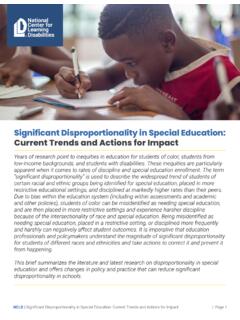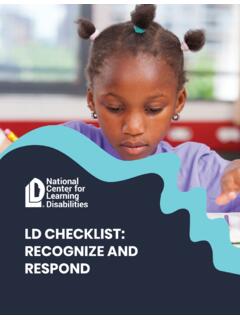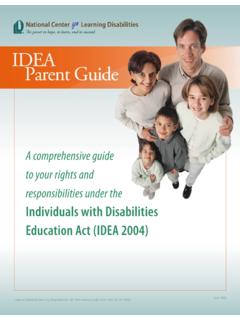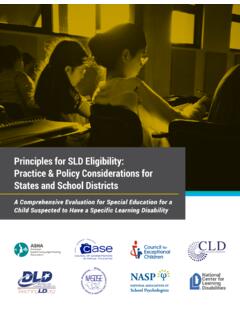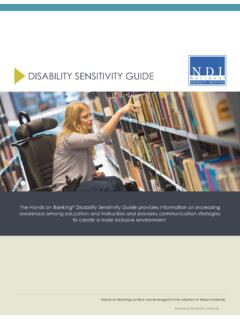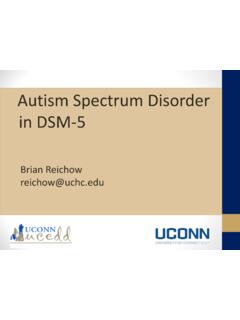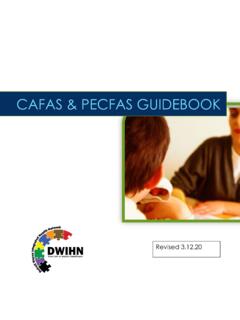Transcription of The State of Learning Disabilities - NCLD
1 Third Edition, 2014 The State of Learning DisabilitiesOur Mission The National Center for Learning Disabilities (NCLD) is committed to improving the lives of all people with Learning difficulties and Disabilities by: empowering parents enabling young adults transforming schools creating policy and advocacy impactWe envision a society in which every individual possesses the academic, social and emotional skills needed to succeed in school, at work and in life. 381 Park Avenue South, Suite 1401, New York, NY 10016-8806 Phone: Fax: , , , , State of Learning DisabilitiesFacts, Trends and Emerging Issues (Third Edition, 2014) A publication of the National Center for Learning Disabilities Executive Director: James H. Wendorf, National Center for Learning DisabilitiesAuthors: Candace Cortiella, The Advocacy Institute Sheldon H.
2 Horowitz, , National Center for Learning DisabilitiesWith contributions by: Lynn Newman, , Senior Education Researcher, SRI International H. Stephen Kaye, , University of California, San Francisco Publication Design: Deb Tanner and Fil VocasekCitation: Cortiella, Candace and Horowitz, Sheldon H. The State of Learning Disabilities : Facts, Trends and Emerging Issues. New York: National Center for Learning Disabilities , 2014. 2014 by National Center for Learning Disabilities , Inc. All rights reserved. This publication is provided free of charge by the National Center for Learning Disabilities . Wide dissemination is encouraged! Copies may be made and distributed in keeping with the following guidelines: The publication must be reproduced in its entirety, including pages containing information about the National Center for Learning Disabilities .
3 Copies of the publication may not be sold. ForewordBy Donald D. Deshler, Chair, NCLD Professional Advisory BoardFor more than 35 years, the National Center for Learning Disabilities (NCLD) has provided essential information and needed resources and services to the Learning Disabilities community. And in response to a rapidly changing educational landscape, it has recently broadened its mission to address the needs of the more than one in five children, adolescents and adults who are impacted by Learning and attention issues every day, in school, at home, in the community and in the workplace. This revised and expanded 2014 edition of The State of Learning Disabilities reflects NCLD s commitment to ensuring that everyone who is concerned about the well-being of individuals with or without identified Learning Disabilities has access to the most relevant and updated new report is much more than a collection of facts.
4 It provides an overview of what Learning Disabilities are, of the impact they have on the lives of children during the school-age years and of the ways that they shape the rocky transition that teens and young adults all too frequently have when moving from school to postsecondary educational settings and the workplace. This report has been reformatted to tell a story about the realities of LD in society today: where we ve been, where we are now and where we seem to be heading. It also points to areas of interest and concern where data specific to individuals with Learning Disabilities are either outdated, limited or missing. These areas encompass such topics as Response to Intervention, charter schools, vouchers, online and blended Learning and juvenile justice. Also worthy of mention in this new report is a section devoted to public perceptions of Learning and attention issues.
5 Recent work has yielded results from national surveys and interviews that offer insights into how Learning challenges are understood and misunderstood. These data tell a critical story about the realities of having LD in today s world. We hope that you will read this report, share it with others and reflect upon the story told by the data presented. Please use it to inform the public and create opportunities for all concerned citizens to work together to ensure that individuals with LD achieve their goals at school, at home and in life. Sincerely,Donald D. Deshler, is the Williamson Family Distinguished Professor of Special Education and Director of the Center for Research on Learning (CRL) at the University of Kansas. We Know About Types of Learning Disabilities ..3 Legal Protections for People With LD ..5 Public Perceptions of 2012 Survey of Public Perceptions of Research on Parents of Children With Learning and Attention Issues.
6 9 Emily Hall Tremaine Foundation GfK Roper 2010 Study on Public Attitudes About Children With in the Schools ..12 Prevalence and Characteristics of Students With Performance and School Outcomes ..16LD Beyond and Characteristics of Individuals With LD ..25 Postsecondary ..32 Emerging to Core State Standards and Learning ..37 Accessible Instructional Vouchers ..39 Juvenile .. 1: State -by- State Change in LD Identification Rates, 2006 2011 ..43 Table 2: State -by- State LD Percentage of Total Enrollment and Total Special Education, 2011 ..44 Table 3: State -by- State Race/Ethnicity of Students With LD, 2011 ..45 | The State of Learning Disabilities : Facts, Trends and Emerging Issues | 1 Overviewdescriptions of symptoms and criteria for diagnosing a wide range of disorders. While it is primarily used by mental health practitioners as a guide to achieving accuracy and consistency in diagnosis, there is considerable overlap in its use among professionals in educational and therapeutic settings who provide evaluation and treatment services to individuals of all ages who have Learning Disabilities .
7 The DSM uses the term specific Learning disorder. Revised in 2013, the current version, DSM-5, broadens the previous definition to reflect the latest scientific understanding of the condition. The diagnosis requires persistent difficulties in reading, writing, arithmetic, or mathematical reasoning skills during formal years of schooling. Symptoms may include inaccurate or slow and effortful reading, poor written expression that lacks clarity, difficulties remembering number facts, or inaccurate mathematical academic skills must be well below the average range of scores in culturally and linguistically appropriate tests of reading, writing, or mathematics. The individual s difficulties must not be better explained by developmental, neurological, sensory (vision or hearing), or motor disorders and must significantly interfere with academic achievement, occupational performance, or activities of daily Learning disorder is diagnosed through a clinical review of the individual s developmental, medical, educational, and family history, reports of test scores and teacher observations, and response to academic interventions.
8 (Specific Learning Disorder fact sheet, American Psychiatric Association, 2013)It s necessary to define what a Learning disability (LD) is in order to understand how Americans with Learning Disabilities are functioning today in schools, colleges and workplaces. For the school-age population, the most commonly used definition is found in the federal special education law, the Individuals with Disabilities Education Act (IDEA). IDEA uses the term specific Learning disability (SLD). According to IDEA, SLD is a disorder in one or more of the basic psychological processes involved in understanding or in using language, spoken or written, which disorder may manifest itself in the imperfect ability to listen, think, speak, read, write, spell, or do mathematical calculations. Such term includes such conditions as perceptual Disabilities , brain injury, minimal brain dysfunction, dyslexia, and developmental aphasia.
9 Such term does not include a Learning problem that is primarily the result of visual, hearing, or motor Disabilities , of mental retardation*, of emotional disturbance, or of environmental, cultural, or economic disadvantage. (20 1401 (30)) *Now known as intellectual disability . Procedures for identifying a specific Learning disability , for purposes of establishing the need for special education services, are spelled out in the IDEA federal regulations. (34 CFR ) For more information on the IDEA federal law and regulations, visit Another definition of SLD appears in the Diagnostic and Statistical Manual of Mental Disorders (DSM) published by the American Psychiatric Association. The DSM contains 2 | The State of Learning Disabilities : Facts, Trends and Emerging Issues | We Know About LDLearning Disabilities arise from neurological differences in brain structure and function and affect a person s ability to receive, store, process, retrieve or communicate information.
10 While the specific nature of these brain-based disorders is still not well understood, considerable progress has been made in mapping some of the characteristic difficulties of LD to specific brain regions and structures. Progress has also been made in understanding the interface between genetics and LD, with documentation of LD, ADHD and related disorders occurring with considerable frequency within members of the same families ( , parents, siblings, aunts/uncles, cousins). Learning Disabilities may also be a consequence of insults to the developing brain before or during birth, involving such factors as significant maternal illness or injury, drug or alcohol use during pregnancy, maternal malnutrition, low birth weight, oxygen deprivation and premature or prolonged labor. Postnatal events resulting in LD might include traumatic injuries, severe nutritional deprivation or exposure to poisonous substances such as lead.
